
Not too long ago I wrote a post about corpse medicine; the use of parts of the dead body in medicines. This could take the form of Stroking lumps and bumps with the hand of a hanged man, or including mummified flesh in a remedy. But dead bodies weren’t only used as remedies, they were used to experiment and develop new cures.
This week I have been reading the 1683 English translation of François Tolet’s Treatise on Lithotomy – the operation to remove bladder stones (we have previously explored Samuel Harlib’s search for a cure for this disease). Tolet was lithotomist at Hôpital de la Charité in Paris. His book includes detailed descriptions of how to cut for the stone and remove it from the body, and, in case you needed them, provides illustrations of the tools used and the procedures as well.1 (see here for a video about how images of lithotomy changed over the early modern period)

Credit: Wellcome Library, London.
At several points in the book Tolet mentions the use of dead bodies. He explains that because these procedures are very complex, and surgeons can easily damage the surrounding organs, they should practice on corpses before they try their hand on living patients.
In order to establish whether a patient had a stone lodged at the top of the urethra surgeons would pass a catheter or a medicated candle into the passageway. If it hit an obstruction the surgeon would know what was causing the problems and where about they would need to cut. Many patients were very reluctant to experience this particular diagnostic test. a patient of Sir Hans Sloane in the early eighteenth century was described as having ‘A great prejudice to being search for the stone, and so much that I believe he will never submit to it.’2
Perhaps it is little wonder then that Tolet recommended practising – the chances to perform on a living patient were perhaps limited and it was important to get it right to avoid unnecessary pain and suffering. He explained that in order to practice properly the dead body would need to be slightly modified.
It is very necessary to make an Experiment of this in dead Bodies, by opening the Bladder, and putting Stones therein; and then having stitched up the Parts, to introduce the Catheter by the Yard
He noted later in the text that if surgeons wanted to try performing the ‘High Operation’ for cutting the stone – so called because of where on the body the surgeon made his incision – then it ‘would be necessary to try many Experiments on dead Bodyes’. He likewise claimed that ‘It is good to practise such kind of Operations upon dead Bodies’, when discussing using a trocar (a small tool designed for use in these operations) to relieve patients who suffered from a suppression of urine; this operation was very similar to cutting for stone. Again Tolet provided instructions for how to prepare the cadaver:
for that end, one must with a Syringe Squirt as much matter as possibly he can, into the Bladder, then tie a Ligature about the Yard, and make the Puncton as he hath been described, and then make a dissection of the Bladder, to observe what hath been done, that so he make take his measure for another time
Tolet clearly believed that making cadavers simulate particular conditions would allow surgeons to practice making them better practitioners. This was important as the flow of urine could complicate recovery from these types of operations. For example, Tolet noted that urine dissolved many, medicines making them ineffectual. Other surgeons recorded the life-long difficulties some patients whose incisions did not fully heal or were made in the wrong place, experienced, explaining that such men no longer urinated through their penis but through the holes that remained in their perineum. Tolet does not though make any suggestion about how easy it was for surgeons to acquire corpses to practice on, and this was probably not an option for every surgical trainee.
________________
- Tolet, François, A treatise of lithotomy, or, Of the extraction of the stone out of the bladder … translated by A. Lovell (London, 1683).
- British Library London, Sloane MS 4076, 49.
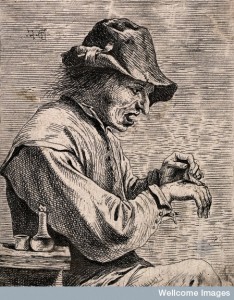
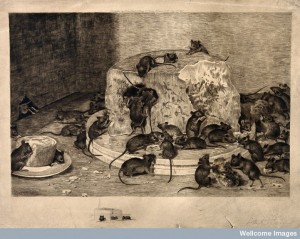
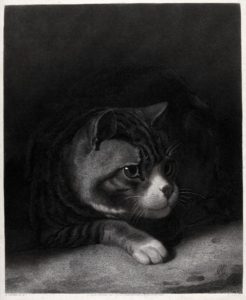
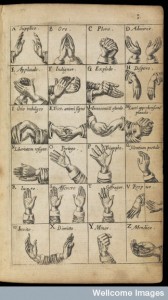
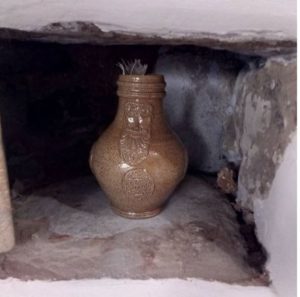
What is a ‘tochet’?
It is a tool used to perform a lithotomy. Although here the spelling is incorrect. I have updated it.
Ah, thank you! Though I suspect the word is ‘trocar’.
Intriguing post; I was a bit puzzled about the ‘high operation’. I had only read of perineal cystolithotomy, using the lithotomy position and a blade introduced to the left of the midline (presumably the surgeons were right handed) midway between the anus and the base of the scrotum, with the blade angled headwards and anteriorly.
A trocar is a pointed instrument used to perforate a hollow organ, and is often used with a cannula, a metal cylinder that fits over it. So, I imagine that the ‘high operation’ is what we would call today a ‘suprapubic puncture’ of the bladder. The perineal route has the advantage of not opening into the peritoneal cavity; if the high operation is what I suspect, as described the bladder would need to be (over)filled with the puncture low down to avoid the peritoneum. Surpapubic puncture and drainage of the bladder is still used today. I’m quite surprised that such procedures were done so long ago —I was unaware of this!
You explained the two operations so much more succinctly than I ever could! The book I read after this one included several rather horrendous examples where the high operation went wrong and the peritoneum was cut. The surgeons talked about the guts falling out into their hands !
Thank you—it helps to have done the operations! I greatly enjoy this series of vignettes: some things have markedly changed, others are remarkably similar to what we do today.
One oddity, and I had to recheck the video; in the illustration above the patient sits in a chair. Likewise in the video, though some of the diagrams show him on his back. I understood that the ‘lithotomy position’ meant the patient on his back, with thighs flexed (pointing upwards) and knees flexed (pointing horizontally)—as if sitting in a chair which had been tipped backwards. This certainly would make it easier for the surgeon. And I hadn’t heard of an ‘operating chair’ such as this before. Any further information?
Not that stuck out in my mind I’m afraid. Other than the book describes one case – and provides an illustrations – of positioning a child on an assistant’s lap in order to perform the operation. I think it came down to practicality. If the chair would facilitate matters then it could be used. The book is available on google books if you want to look through all of the illustrations, or read in more detail.
I’m intrigued now, wondering if I have time to go back through and read again!